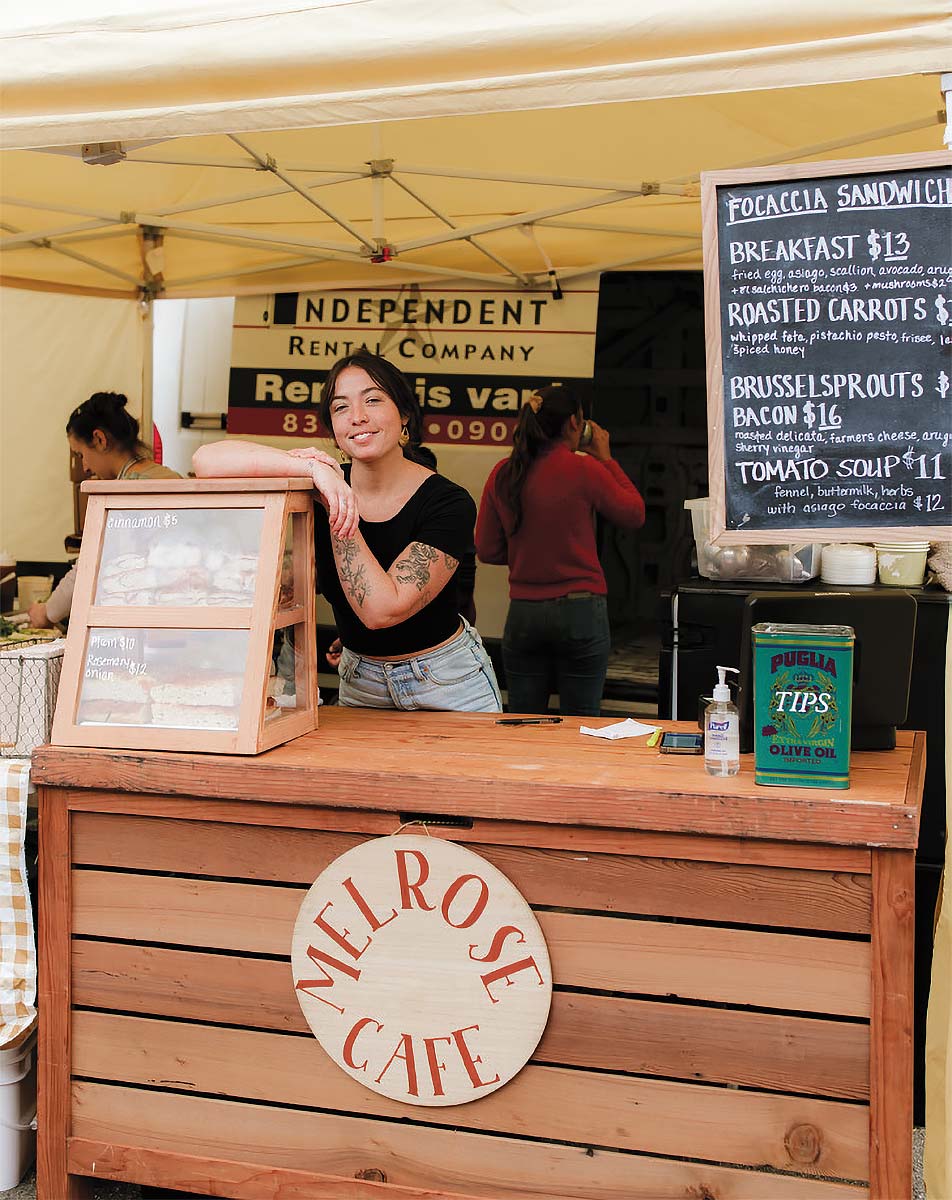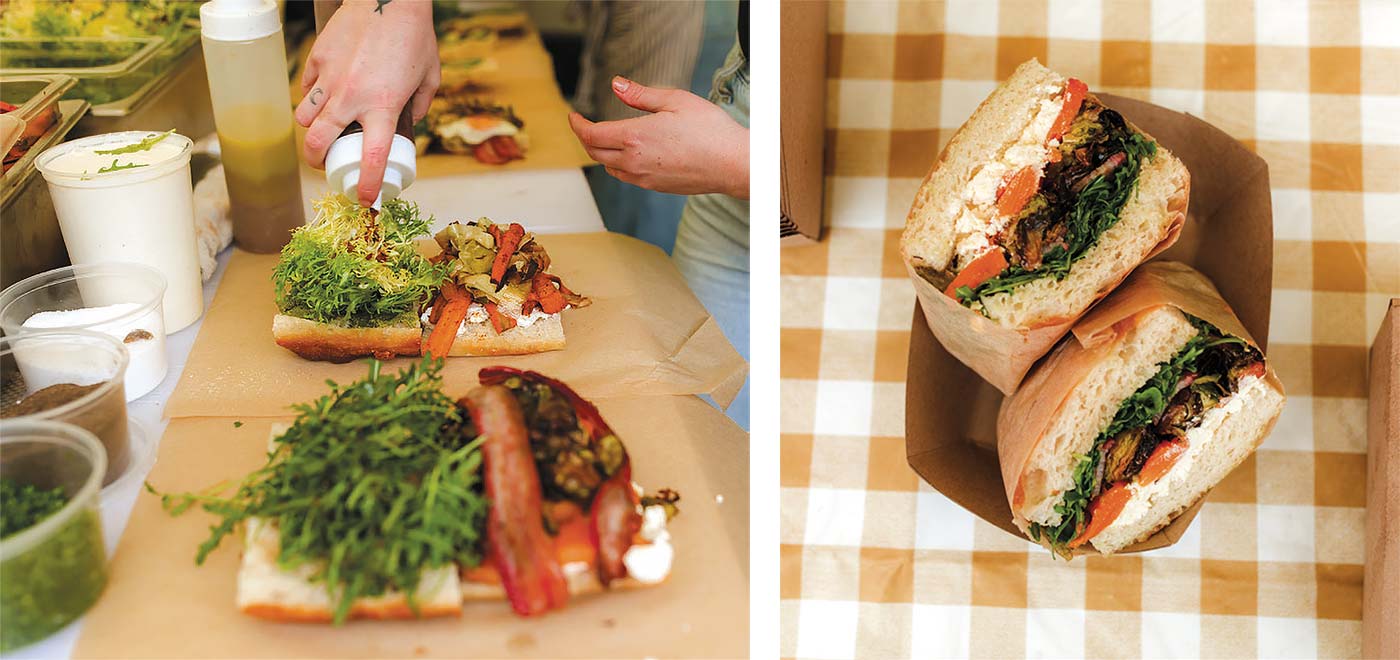
PHOTOGRAPHY BY GENEVA RICO
Superlative focaccia sandwiches are popping up at Santa Cruz farmers markets, thanks to a new incubator program
On any given weekend at the Westside and Live Oak farmers markets, there’s a line in front of Melrose Cafe’s butter-colored tent.
Owner/baker Cameron Meyers can usually be found taking orders or helping her employees assemble her seasonally stuffed focaccia sandwiches.
The pop-up offers a standard breakfast version, with fried egg, arugula, scallion, avocado and Asiago, as well as rotating specials. Depending on the season, there are treats like Fogline Farm porchetta with shaved fennel, apple and mustard seed vinaigrette; an outstanding BLT; or roasted carrots with whipped feta, pistachio pesto, frisée, caramelized leeks and spiced honey.
Meyers, a native of Santa Cruz, grew up in a family of avid home cooks, but her first kitchen job was working the pantry station at La Posta, at 19, under thenexecutive chef Katherine Stern. Meyers worked her way up to line cook, eventually moving on to Bantam in Santa Cruz and Home in Soquel.
“Spring is my favorite time for produce,” Cameron Meyers says—which means focaccia sandwiches made with fava beans, peas, asparagus, artichokes and fresh chevre.

In 2020, Meyers helped Stern launch her pandemic-era Midway pop-up at the Westside and Live Oak farmers markets—and spent her summers helming the kitchen at Kachemak Bay Wilderness Lodge in Alaska.
Last fall, Meyers launched Melrose Cafe, with help from longtime Santa Cruz Community Farmers Market Executive Director Nesh Dhillon. “Like Katherine, Cameron’s ethos was right in line with what we wanted,” Dhillon says.
When Stern discontinued her pop-up to focus on The Midway’s brick-and-mortar eatery, Dhillon and his team sought a replacement who also prioritized seasonal ingredients sourced from the market.
When Meyers approached him in October of 2023, the timing was serendipitous. “Cameron understood what we needed,” says Dhillon. “She saw the process of development and execution with The Midway pop-up, and the market needed another farm-to-pop-up prepared food concept built around a dedicated seasonal approach and commitment to the growers. And her focaccia is amazing.”
Meyers, for her part, is equally impressed with Dhillon and his team. “He’s such a strong proponent [of] community involvement, and the markets themselves are such a special place—a lot of that is because of him,” she says. “He really pushes to make things happen.” As for that amazing focaccia, it’s rare to find a self-taught baker with Meyers’ talent. She initially began baking “for fun,” but in Alaska, she found it useful, as sourcing was limited. In addition to smoking her own meat and fish, she made her own yogurt and baked goods, including a fluffy focaccia.
“I developed a recipe that didn’t require starter, just overnight proofing,” she says. When Nesh and I first connected, I had this half-formed idea that I wanted to do focaccia sandwiches.” Dhillon and Meyers began fleshing out the concept, with a view toward making Melrose a model for future prepared-food vendors and farms selling valueadded items from their produce, like jam, salsa and pickles.
“The idea of empowering food offerings at the markets is something I’ve thought about for a long time,” says Dhillon, noting every market is different, from location and demographics to vendor composition, timing and location. “If you don’t have a customer base showing up, your business won’t work—markets have to create infrastructure that supports and pays for itself. But they’re also flexible and dynamic, and able to pivot easier than a restaurant or grocery store.”
He adds it’s imperative that all vendors are a good fit and fill a niche within their specific markets. To ensure that, he helps new vendors go into the season with a plan and “see it through, so we have empirical data instead of conjectures.”
“There’s a method to all of it, so we can devise a bigger picture,” he says.
While some prepared food vendors do source specific ingredients from their fellow growers, Dhillon’s goal is to fully vertically integrate new businesses as the markets grow into their next phase of development, which will coincide with the relocation of the downtown market and development of an adjacent, local agriculturedriven
food hall.
“What we’re doing is reverse engineering products and concepts, where we develop an idea and then find the right partner,” Dhillon says. “Prepared food vendors can’t realistically or cost effectively have every single ingredient sourced from the market, so we need to build flexibility into our criteria. But we really need to start looking at what percentage of product [they’re using] that’s from our growers and our county. It’s also an educational opportunity for consumers.”
To that end, Meyers does the shopping for Melrose at the Wednesday downtown farmers market, and she estimates that 95% of her produce is sourced from local growers like Dirty Girl Produce, Groundswell Farm, Happy Boy Farms and Blue Heron Farms.
“I need to keep my price points stable, so I’m thoughtful in my sourcing,” she explains.
At the commercial kitchen space she rents in Santa Cruz, Meyers mixes all her dough by hand in 140-pound batches the night before the markets.
“It’s important for quality that we bake our focaccia the morning of the markets,” she says, noting that on busy days, she and her team—which sometimes includes her sister and parents—will assemble and sell more than 200 sandwiches.
Melrose Cafe also sells quarter-loaves and the occasional pastry special, like coffeecake. Rainy days expand to include grilled cheese or soup, like San Marzano tomato with buttermilk, herbs and Asiago focaccia.
“As a former market vendor [for Pescadero’s celebrated Blue House Farm], I know what it’s like to work when it’s cold and slow,” Meyers says. “I wanted to support the vendors by giving them something hot to eat.”
Because the pop-up launched in September, Meyers has yet to experience a full season, but she’s excited for spring—“My favorite time for produce,” she says—which means sandwiches made with fava beans, peas, asparagus, artichokes and fresh chevre.
As for the future, Meyers says her plate is currently full.
“We’re figuring it out as we go,” she says. “I’m a big fan of waiting to see what happens.”
A WAVE OF OPPORTUNITY
Fresh ideas find a foodhold in market setting
Many prepared food vendors use the markets as a launchpad for bigger endeavors. SCFM Executive Director Nesh Dhillon cites Farmhouse Culture as an early success story.
In 2008, founder/chef Kathryn Lukas began selling her market-sourced fermented food products at the downtown market. She eventually increased her range to 14 markets throughout the region and San Francisco Bay Area before expanding to larger retail outlets.
“Farmers markets were our proving ground, allowing us to text our products, refine our branding and validate our business model in real time,” says Lukas, whose company was sold in 2020. “They also provided crucial immediate cash flow and helped generate the capital we needed to launch a national brand.”
Other market vendors that have gone on to open their own brick-and-mortar businesses include The Midway, 11th Hour Coffee, Jayne Dough/La Marea Café and El Salchichero.
“In this way, farmers markets are creating a new wave of opportunities for culinary businesses,” says Dhillon. “It’s an incredible incentive for Santa Cruz County food artisans and chefs, and we hope to inspire other regions to do the same.”
About the author
Laurel Miller is a food, spirits and travel writer and the former editor of Edible Aspen. She grew up on a California ranch and has been writing about regenerative agriculture for over 20 years. When she’s not tethered to her laptop, Miller enjoys farmers markets and any trip that requires a passport. She’ll take a Mission burrito over a Michelin star, any day.
- Laurel Millerhttps://www.ediblemontereybay.com/author/laurelmiller/
- Laurel Millerhttps://www.ediblemontereybay.com/author/laurelmiller/
- Laurel Millerhttps://www.ediblemontereybay.com/author/laurelmiller/
- Laurel Millerhttps://www.ediblemontereybay.com/author/laurelmiller/



